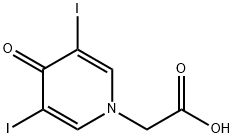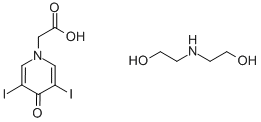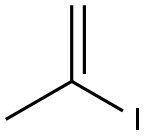3,5-DIIODO-4-PYRIDONE-1-ACETIC ACID
- CAS NO.:101-29-1
- Empirical Formula: C7H5I2NO3
- Molecular Weight: 404.93
- MDL number: MFCD00006185
- EINECS: 202-932-5
- SAFETY DATA SHEET (SDS)
- Update Date: 2023-05-04 17:34:30

What is 3,5-DIIODO-4-PYRIDONE-1-ACETIC ACID?
Originator
Iodopyracet,Winthrop
The Uses of 3,5-DIIODO-4-PYRIDONE-1-ACETIC ACID
3,5-Diiodo-4-pyridone-1-acetic Acid is used in contrast media.
Definition
ChEBI: Diodone is a 4-pyridone in which the pyridone is iodo-substituted at C-3 and -5 and has a carboxymethyl substituent on nitrogen; used as a radiocontrast agent urography. It has a role as a radioopaque medium. It is a member of 4-pyridones, a monocarboxylic acid and an organoiodine compound.
Manufacturing Process
2 mol of pyridine are reacted with thionyl chloride to give 4-pyridyl-pyridinium chloride. The last one is transformed into 4-1H-pyridone by adding of water at 150°C. Then it is added to 1 mol of iodomonochloride (ICl) to give 3,5- diidopyridone. It is converted in 3.5-diiodo-4-pyridone-N-acetic acid by addition of chloroacetic acid and sodium hydrate. 1 mol of 3.5-diiodo-4- pyridone-N-acetic acid is dissolved in a solution of 1 mol of diethanolamine in 60 ml of water while heating. The solution is made up to 100 ml with water. After evaporating the solution and recrystallizing, the salt is obtained in the form of white crystals. MP: 153°C.
Therapeutic Function
Diagnostic aid
Properties of 3,5-DIIODO-4-PYRIDONE-1-ACETIC ACID
| Melting point: | 244°C (dec.) |
| Boiling point: | 422.8±45.0 °C(Predicted) |
| Density | 2.2000 (rough estimate) |
| refractive index | 1.7400 (estimate) |
| pka | 3.60±0.10(Predicted) |
| Water Solubility | 2.787g/L(temperature not stated) |
| Sensitive | Light Sensitive |
| CAS DataBase Reference | 101-29-1(CAS DataBase Reference) |
Safety information for 3,5-DIIODO-4-PYRIDONE-1-ACETIC ACID
| Signal word | Warning |
| Pictogram(s) |
 Exclamation Mark Irritant GHS07 |
| GHS Hazard Statements |
H315:Skin corrosion/irritation H319:Serious eye damage/eye irritation H335:Specific target organ toxicity, single exposure;Respiratory tract irritation |
| Precautionary Statement Codes |
P261:Avoid breathing dust/fume/gas/mist/vapours/spray. P264:Wash hands thoroughly after handling. P264:Wash skin thouroughly after handling. P280:Wear protective gloves/protective clothing/eye protection/face protection. P304+P340:IF INHALED: Remove victim to fresh air and Keep at rest in a position comfortable for breathing. P305+P351+P338:IF IN EYES: Rinse cautiously with water for several minutes. Remove contact lenses, if present and easy to do. Continuerinsing. P405:Store locked up. |
Computed Descriptors for 3,5-DIIODO-4-PYRIDONE-1-ACETIC ACID
New Products
Tert-butyl bis(2-chloroethyl)carbamate 4-Methylphenylacetic acid N-Boc-D-alaninol N-BOC-D/L-ALANINOL 3-Morpholino-1-(4-nitrophenyl)-5,6-dihydropyridin- 2(1H)-one Furan-2,5-Dicarboxylic Acid Tropic acid DIETHYL AMINOMALONATE HYDROCHLORIDE 1,1’-CARBONYLDIIMIDAZOLE R-2-BENZYLOXY PROPIONIC ACID 1,1’-CARBONYLDI (1,2-4 TRIAZOLE) N-METHYL INDAZOLE-3-CARBOXYLIC ACID (2-Hydroxyphenyl)acetonitrile 4-Bromopyrazole 5-BROMO-2CYANO PYRIDINE 5,6-Dimethoxyindanone 5-broMo-2-chloro-N-cyclopentylpyriMidin-4-aMine 2-(Cyanocyclohexyl)acetic acid 4-methoxy-3,5-dinitropyridine 2-aminopropyl benzoate hydrochloride 1-(4-(aminomethyl)benzyl)urea hydrochloride diethyl 2-(2-((tertbutoxycarbonyl)amino) ethyl)malonate tert-butyl 4- (ureidomethyl)benzylcarbamate Ethyl-2-chloro((4-methoxyphenyl)hydrazono)acetateRelated products of tetrahydrofuran








You may like
-
 3,5-DIIODO-4-PYRIDONE-1-ACETIC ACID CAS 101-29-1View Details
3,5-DIIODO-4-PYRIDONE-1-ACETIC ACID CAS 101-29-1View Details
101-29-1 -
 1975-50-4 98%View Details
1975-50-4 98%View Details
1975-50-4 -
 2-HYDROXY BENZYL ALCOHOL 98%View Details
2-HYDROXY BENZYL ALCOHOL 98%View Details
90-01-7 -
 2-Chloro-1,3-Bis(Dimethylamino)Trimethinium Hexafluorophosphate 221615-75-4 98%View Details
2-Chloro-1,3-Bis(Dimethylamino)Trimethinium Hexafluorophosphate 221615-75-4 98%View Details
221615-75-4 -
 61397-56-6 CIS BROMO BENZOATE 98%View Details
61397-56-6 CIS BROMO BENZOATE 98%View Details
61397-56-6 -
 14714-50-2 (2-Hydroxyphenyl)acetonitrile 98+View Details
14714-50-2 (2-Hydroxyphenyl)acetonitrile 98+View Details
14714-50-2 -
 118753-70-1 98+View Details
118753-70-1 98+View Details
118753-70-1 -
 733039-20-8 5-broMo-2-chloro-N-cyclopentylpyriMidin-4-aMine 98+View Details
733039-20-8 5-broMo-2-chloro-N-cyclopentylpyriMidin-4-aMine 98+View Details
733039-20-8